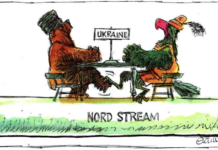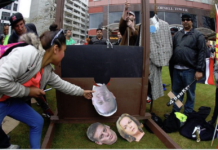
This week an unsolicited EziBuy brochure turned up in my mail box. It was unnecessarily wrapped in plastic, and unappealing in its styles, utopian in its settings, unrealistic in its prices. But there was a more insidious underlying issue that took a while to become apparent. Of the 117 pages, including front and back, there were only about five that contained any images of dark skinned women.
When I observed on that great stewing cauldron of opinion, Facebook, that there were virtually no ‘women of colour’ in EziBuy pages, I was told I was homogenising women. (Sorry to every one of you!). I was told the descriptor ‘of colour’ was an ‘Americanism’; I should have referred to Indian, African-American, Maori, Pacifica…. While labels matter, racism itself is of broader concern.
The absence in EziBuy of pictures of Maori, Asian, Pacific, Middle Eastern women of all ethnicities and nations, and other women who make up the diversity of New Zealand life, meant that women different from a ‘white’ homogenous ‘standard’ were made subject to ‘symbolic annihilation’. They were made invisible, denormalised, diminished. And given the role the media of all types plays in shaping views of ourselves and the world, EziBuy failed to reflect, speak to, or even acknowledge the beautiful diversity of New Zealand women. That every woman in the catalogue met a rare and unrealistic standard of ‘perfect’ teeth, hair and height, was a bad enough signal to real women everywhere, but the absence of real, diverse New Zealand women, said only white women (of certain Aryan characteristics) are and can be, beautiful and suitable for wearing EziBuy clothes.
In the long Facebook discussion that followed, I was told that ‘we should just get over it and stop whining and making politics out of everything’. “We should all be one people”. Someone I’m fond of said I should just face up to the fact that we are white New Zealand.
I double checked New Zealand’s demographic figures, which confirmed we are definitely not ‘white NZ’, but are 14+% Maori, 11% Asian, 7+% Pacifica, plus other ethnicities, and just 72% are ‘European New Zealanders’. Certainly when I walk down an Auckland street it looks a lot like a mixed modern city to me. And all the richer for it. Though no wonder attitudes of European entitlement and privilege prevail. It was only in the 1970s that New Zealand stopped selecting immigrants just based on their European descent, and instead accepted them on more equal basis of skills, financial capacity and family links. We’re dealing with a culture that’s still striving to retain its dominion.
The recognition and denigration of others based on physical characteristics is said to stem from unity of tribal group bonds and fear of those who are different. Racist stereotypes have long been used in this country to justify a settler society and colonisation. Claims that we should have ‘one (white) law for all’, and be ‘one’ New Zealand, assume a systematic Euro-centric superiority, dishonour the Treaty, insult bi-culturalism and thwart opportunities for recognition and celebration of indigeneity, and diversity.
Diversity and different skin colour and dress in our communities is an obvious sign of social change, and those with established privilege or status, even if they can’t see it themselves, will feel threatened by change and by a society they perceive as filled with others. There’s casual racism and every day bias against Indian shopkeepers and bus drivers, women in headscarves, Maori, ‘Asian homeowners’. Fourth generation kiwis of Chinese descent get told to go back where they came from. A whole range of derogatory terms are used to describe good, hard working kiwis who, if they had the same skin colour as the dominant paradigm and its narratives, wouldn’t raise an eyebrow. In many cases, prejudice works against people just because of the colour of their skin not because of the fact that they’re foreigners though – there’s less bias against immigrants from England, Australia or Europe, than there is against indigenous Maori and Pacific Islanders, or people of ‘different’ colour.
That’s because colour is a proxy for political inequality – power imbalance. Who needs a brand or a label to highlight the target of your opposition when simple pigment will do. Racism is, according to sociologists, ‘a political construct, primarily a manifestation of unequal power between groups’. It’s the machinery of an ‘ethnocentric paradigm’ which maintains those unequal power relations.
The absence of ethnically diverse women in fashion magazines as part of media bias, ‘defines the contours of society’, shapes our understanding of the world, how we see ourselves, how we are seen, and helps create ‘social identities and realities’. It’s a form of ‘racial framing’.
So while some said ‘it’s just a magazine selling clothes, don’t read too much into it’, the racism problem goes further than just in magazines. There’s evidence from the Human Rights Commission that racism is getting worse though most victims of racism ‘suffer in silence’ according to Commissioner Susan Devoy. And racism works on all fronts, there’s internal, interpersonal, institutional, and societal racism affecting individual’s health, wellbeing, experiences and life chances in the workplace, public sector and in the provision of goods and services. It’s been seen in popular culture from ‘My Kitchen Rules’, to the NZ Music Awards. It’s expressed in differential access to health care, education, rental accommodation, and in unequal treatment through the criminal justice system.
It was pointed out that EziBuy is an Australian owned company, as if that explains the homogenous white women filling their pages. It certainly doesn’t excuse it. But given New Zealand and Australia are richly ethnically diverse and are both target audiences for the magazine and the company’s clothes, it would be wholly appropriate to include images that represent the real women of those countries. In fact, EziBuy started as a New Zealand company, before it was bought by Coles and then Woolworths, so it has had quite an opportunity to reflect the make-up of its country of origin. Their head office is in Parnell.
There were no pictures of models with t-shirts saying ‘I’m racist on the inside’ in the EziBuy magazine, to adopt an angle from the Human Rights Commission’s ‘Give nothing to racism’ campaign fronted by Taika Waititi. And even when we think we’re (one) colour blind, we’re seeing the world from a particular lens. The concerning thing about the EziBuy catalogue was that it presented a (series of) false realities as if they were ideals. Though there was no ‘I’m racist on the inside’ label on the cover, its pictures spoke a thousand words, if only you read between the lines.





What you write about has been so widespread for so long that it will probably take a Weinstein-like event egregious enough to make it into the headlines.
That said, I occasionally see TV ads and they are much more diverse that they were but twenty years ago. And if Ezibuy are happy to alienate so much of their possible market I’d suggest their shares aren’t a good investment.
I think you will find that ethnic women are well represented in luxury brands.
Ezibuy mail order catagolues reflects the poorer ethnicity of the consumers of ezibuy and their time poor status.
Ezibuy is not exactly Gucci.
Go around to the banks and luxury stores in Auckland and I think you will find the ethnic diversity you seek. It actually speaks of a reality totally opposite to what you are trying to say. Where the money is.
Liberals no longer need to weep into their tea cups about poverty – the worlds richest billionaires are well represented ethnically across the globe. Money is no longer about ethnicity.
NZ being part of Asia is considered one of the poorer regions and more looked on as a place to be exploited for assets and resources. Most global companies in NZ report to Singapore or China.
The world’s richest billionaires are from all corners of the earth. No need to worry.
https://www.forbes.com/billionaires/list/#version:shttps://www.forbes.com/billionaires/list/#version:static
Good on ya Christine, the lack of diversity in a second-rate online clothing catalogue no-one cares about to really concerns me too. It’s right up there with trangender people choosing which toilets they’ll use in keeping me awake at night. Great quote from Judith Collins’ wonderful HRC appointee “Dame” Susan Devoy as well.
+1 SIMONM, I too can’t sleep with the Ezibuy scandal and labelling of toilets.
I’m sure that Ezibuy representation would be just up Susan Devoy and NZ Human rights commission. I have noticed the more trivial the issue the more the establishment seems to be keen to take it on.
Serious human rights can then remain under the radar while human rights resources and media can focus on issues minor and one dimensional. The effect is to devalue the idea of human rights and make the public sceptical about them.
Atrocities in Afghanistan by our own forces for example… evicting state house tenants so their houses can be sold, disabled having to queue at WINZ and their permanent illnesses having to be investigated yearly etc etc. TPPA that gives many less future, Kids being expelled and excluded by schools and special schools being closed down. Mass surveillance and abuse of that to peaceful activists not the mythical Jihardi brides from Oz.
Why not do something and write about that because it’s happening here and now in our own country. Feminism was the focus in the 70’s, ethnicity in the 80’s.
For 30 fucking years we have been plagued by neoliberalism while the lefties get bogged down with identity politics and think if women, people of colour and those with different sexualities can get a few trivial gains then their job is done.
Look around people have much bigger and major problems in the pipeline than Ezibuy.
I write plenty about wider injustices too if you care to look back. It doesn’t make these concerns any less.
spot on christine.
If you really feel that the biggest fight right now is having more diverse representation in an EZIBUY catalogue, which is geared towards middle class white housewives, you are not a socialist.
Christine Rose really had to fish around for an article like this to fill her quota,just stirring the pot,i doubt Maori and Pacific island people gives a hoot.If you don’t like the pictures don’t buy the goods!!!!!
Christine, you don’t understand marketing.
Brown women aspire to buy the clothes that white women wear.
If they had a catalogue full of brown faces, fewer brown people would buy them.
Ironic isn’t it? But nevertheless true.
Well I don’t understand marketing much either, Andrew, but at least I admit it.
what a load of bull Andrew
“Certainly when I walk down an Auckland street it looks a lot like a mixed modern city to me.”
Looks like a concrete slum to me.
Benn: “Looks like a concrete slum to me.”
Heh, doesn’t it just! Queen St looks very down-at-heel now, and when one walks up Victoria St and the smell of the sewers is pervasive, it suggests a city centre which has reached the limits of its capacity to cope with increased population.
Hi Christine, many thanks for pointing out the obvious, I have now cancelled my subscription to the Ezibuy catalogue, something I should have done long ago. I remember being in the centre of Kuala Lumpar 20 years ago in a big multistory shopping complex and pondering on the many global brands and their numerous pictures of models wearing their stuff, all of them clearly thin white, US models… Clearly none of their products were made for indigenous Malaysian women. It is extremely tiresome that these sorts of problems go on and on and on.
pasifika
The Australians have wrecked Ezibuy in a few years.
Just like our railways with Toll.
This article is frightening facile. Must middle eastern women shun their cultural modesty so that Easyby can avert racist slurs from Western libs?
I am on Italian heritage an saying ‘Eurpean’ does not clearly identify the problem as folks from certain Mediterranean countries have experienced discrimarion in this country and it was really bad in Australia up until the 1970/80 it is still in some parts in Australia even now, it is still here also but in hidden and insidious ways. However it was also still open here in the 70’s and 80’s. As a family we could tell you of it especially the references to the ‘mafia’. But things like telling people, who could not speak English to speak English on places like buses when they were speaking to their friend in Italian. Referring to people as smelling of garlic my mother would not touch garlic because of that. Italians having to change there name to an English name as people could not say there name my ‘uncle Bob’ told about his name it was ‘Anello’ but he used ‘bob’ he said they can spell that. My name is Italian but people insist on the English spelling I have even been asked if I have spelt it correctly even at ‘teachers college’ in 1987. No we have racist against certain Mediterranean countries and that includes Greece also as I have friends Greek and have heard their stories also. Then following that, the discrimation that I have felt against someone of the Catholic religion that has been rampant in this country and that goes as far as jobs and promotions etc. we are a people who do not like minorities or anyone different to our own reflection of the mirror is my observation in all this. It has been at the tolerance of the old Italians that this has been left unsaid as they did not want trouble they came here in the early 1900’s and they just wanted a better life than the one they left behind but food, language, religion and culture made that very hard for these people and they suffered in silence.
Male models are usually tall and have narrow shoulders. I’m slightly (only slightly!) below-average height but rather broad shouldered (all those maritime and coal mining forebears no doubt). I’d also say that most male models are noticeably better looking than me.
But I’m not asking them to replace half of the models on clothing websites I like to get my gear from with Peter Dinklage and the dude who plays Samwell Tarly so that I can feel better about how I look in a Fred Perry polo. I don’t feel invisible because taller and more handsome dudes than me are the ones who get paid to model Scandinavian denim. Models are meant to make clothing look impossibly good so it’s desirable. Desire of course is the key, Hegel understood it well and it terrified Marx.
I am astonished at people making comments around the idea that there are more ‘important’ things to complain about or discuss. Get on and write for the Daily Blog and send it to Mr Bradbury. As a recipient of their regular mags I have now contacted them and gone on their ‘live chat’ and explained why I no longer wish tor eceive their catalogues: https://www.ezibuy.com/shop/nz/login/liveChat
We need to stamp out racism whereever it is! Good on you Christine.
72% is a pretty big corner of the market. And by the way, apparently ‘African-American’ is no longer acceptable. The argument is, they are not hyphenated Americans but actual Americans. Keep up – progressive racial politics is a fast moving game.
“The absence in EziBuy of pictures of Maori, Asian, Pacific, Middle Eastern women of all ethnicities and nations, and other women who make up the diversity of New Zealand life, meant that women different from a ‘white’ homogenous ‘standard….”
This is the trap of identity politics, in which diversity is characterised only by skin colour. It is the same trap into which Mai Chen has unfortunately fallen.
In virtue of what should you suppose that a group of white women isn’t ethnically diverse? The concept of diversity isn’t exhausted by skin colour. One might as easily use eye or hair colour, or eye shape. Bear in mind that many people who we would see as white have the epicanthic fold, for instance.
Those of us who are white come from very diverse ethnic backgrounds, which will doubtless apply to the Ezibuy models; many of us take exception to this sort of polemic, which just comes across as white guilt. We need more of that like we need toothache.
“…every woman in the catalogue met a rare and unrealistic standard of ‘perfect’ teeth, hair and height….”
You do realise, don’t you, that they’ll all be photoshopped – including the brown women? We all know it. You’d be justifid in taking a poke at that: just leave the skin colour furphy out of it.
“There were no pictures of models with t-shirts saying ‘I’m racist on the inside’ in the EziBuy magazine, to adopt an angle from the Human Rights Commission’s ‘Give nothing to racism’ campaign fronted by Taika Waititi…”
Good grief! I sure hope not. This “racism” meme is another furphy, which is beginning to sound disturbingly like the “Reds-under-the-bed” hysteria of my youth. Don’t conflate societal prejudice and bias with racism: it isn’t. Racism is what governments do: the apartheid of South Africa and in particular the southern states of the US prior to the civil rights movement (also in my youth), are exemplars.
Call out prejudice if you want to, but remember that we live in a polity which values free speech. You may not like manifestations of it, but it doesn’t follow that it should be shut down.
WHERE is my comment???????????
From 2 days ago
???
Comments are closed.